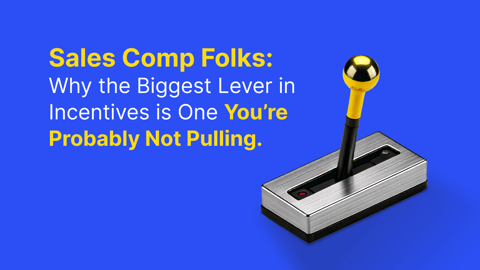Wouldn’t it be great to create a sales compensation program that you could set up once, let it run, and then tweak it a bit for next year, and then let it run again? ‘Rinse and Repeat’? Just think how much time and energy you’d get back by not worrying about your sales incentives.
Of course, the real world is much more complicated. But the idea that sales incentive management could be managed more scientifically is attractive. After all, you likely have tens or hundreds of years of sales experience and a deep understanding of your markets and customers. The idea that you can apply some of these insights to your sales incentive planning probably sits at the back of your mind if you can capture it all and use it to design the ‘perfect’ sales incentive plan.
Using this type of insight is perfectly possible. Let’s explore how to use these deep sales insights to help you maximize sales performance.
1. Let Your Reps Know How They’re Performing in Real Time
Regular feedback lets reps see their performance against their goals and helps them decide which customers to prioritize to hit their quota. Better reporting gives them the autonomy to make the best use of their time, whether it’s closing deals or building more pipelines.
If you’re making your sales reports in Excel or another manual tool, provide regular reports on their performance, not just a final report after the sales period is closed; it’s too late to fine-tune their sales activity by then. Alternatively, use a platform that automatically provides real-time results so they can see where they are and which deals will most likely get them to President’s Club this year.
2. Introduce More Achievement Tiers
When we have an achievable goal, we work harder to achieve it. Once we’ve mastered that goal, a more demanding goal can feel more attainable. Compensation management can mean having a more nuanced view of quota setting. Maybe you have easier sales targets earlier in the year and more stretching ones at the end, or perhaps you steadily introduce more demanding – but achievable – targets as people progress their careers with you, along with higher rewards.
3. Leave the Past in the Past
Annual quotas can demotivate reps if they’ve had a bad month or quarter; they end up feeling like they’re in a hole they can’t climb out of. You want everyone to focus on the now and what they can move forward today. We all have good and bad days. Shorter quota cycles give your sales team the safety to have some bad days. If you’re on an annual cycle, divide quotas quarterly or monthly, and keep a yearly bonus to keep star performers on board.
4. Build the Right Sales Habits
Identify the ideal sales behaviors for offerings in your market. Build a blueprint for each rep to hit quota, as most reps don’t know the leading indicators. What’s the ‘right’ number of meetings you need to close a deal? How many contacts do you need, and in which departments or functions? How long are all the stages in your sales cycle? If your salespeople know what ‘good’ looks like, they can emulate and plan for it, increasing the chances of success for them and you.
You can even find out which behaviors work best at each sales stage. It could be more volume at the pipeline-building stage but with more finesse at the negotiation stage. Deep sales insight allows you to build the ‘model salesperson’ to spread best practices throughout your organization.
5. Don’t Set Accelerators That Are Too Rich
This idea goes against the grain because, in theory, the more a salesperson can earn, the harder they’ll work, right? High accelerators may encourage people to work harder, but they may also take more risks with your business. A salesperson might spend time developing that one big deal that blows their quota out of the water and maybe earns them a life-changing sales commission.
The problem with this is what happens if it doesn’t come in. The salesperson will likely move on, but you still have to pay their base salary and other costs while getting very little in return. Equally, closing this epic deal might cause more problems than its worth. The contract terms may be too onerous or involve additional investments that impact profitability.
6. Turn Off the Leaderboard
This one may also go against the grain, but it makes sense. Sales leaderboards are a traditional motivational tool that creates friendly competition amongst the sales team. This may work if you’re selling large volumes of the same product, but it becomes more problematic if you sell a range of products to customers who buy from you differently.
The picture presented by a leaderboard can become very confusing, as your salespeople are engaged in very different sales situations, and any comparisons quickly become meaningless. Those at the bottom of the same ladder will become demoralized, even if they work very hard, perhaps promoting less well-established products. At the other end of the leaderboard, it can offer every temptation to those at the top to take their foot off the gas.
7. Invest in Sales and Product Training
It’s essential to ensure that your sales team has the right skills. Skills fade over time if they aren’t fully used. So, make sure you don’t fall into the trap of thinking people will learn on the job. Without direction, they’ll likely pick up bad habits that’ll impact their effectiveness.
Technical and product skills are necessary as you develop new offerings that your salespeople need to understand while learning how best to deal with your competitors. Other skills, like visualization and personal development skills, can help with the resilience key to the most effective salespeople. Applying your deep sales insights will help you design a training and development program that increases your chances of success.
8. Show the Route to Success
Salespeople are traditionally skeptical of how their quotas are set. They may feel they’re set too high and not rooted in reality. Some of this thinking is emotional, and some of it is reasonable. To help them start their sales campaign, you could show them how you developed your quota model and where the opportunity might be. Getting this buy-in helps your salespeople focus faster and get productive sooner.
9. Align Your Sales Incentives with Your Sales Strategy
There’s little more point in creating an incentive plan that works against your sales strategy. Suppose you want to use a solution-selling methodology, but pay your salespeople on an uncapped commission-only basis. In that case, you’ll likely have a high turnover of salespeople who can’t sustain long sales campaigns without pay. Equally, customers will be angry that you can’t follow through on the commitments your salespeople made on your behalf.
Instead, create an incentive model based on how your customer wants to buy. If they need to understand how your offering can solve their business problems, you could reward your salespeople based on meetings arranged, contacts made, and revenue closed. Or you could pay your salespeople on their customer revenue, regardless of the channel they use, whether direct, through your partners, or online, if your customer prefers to buy from you in different ways.
10. Improve Sales Productivity
One way to get better results is to allow your salespeople to focus more on their day job than trying to negotiate a difficult-to-understand commission process or taking time to sort out commission disputes. Give them a platform to understand their incentives, see how they’re paid, and utilize a simple-to-use dispute resolution process. This frees up the sales team’s time and that of busy sales managers and sales operations teams.
Find out more about how we can help you create a better compensation plan by reading our eBook, How to Create Better Compensation Plans in 2023
*Originally published on March 18, 2021 - updated on July 4, 2023



